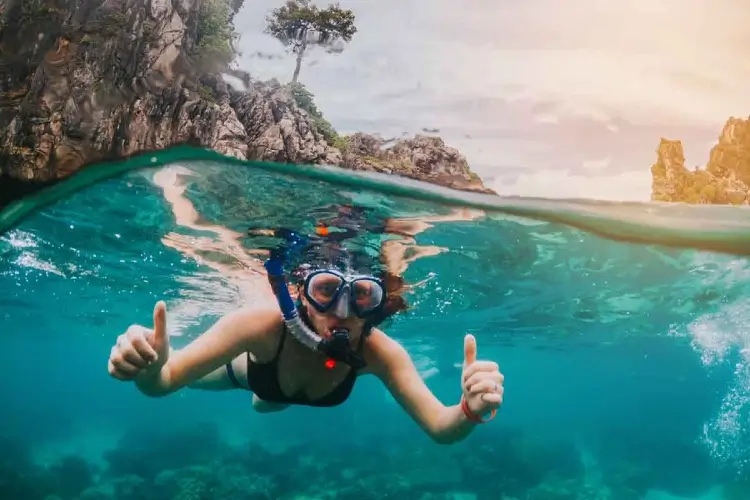Do snorkelers use hand signals? This is a common question among those new to snorkeling.
In this article, we will explore the importance of hand signals in snorkeling, common signals used, how sign language improves communication underwater, safety tips and mastering them for a better underwater experience.
The Importance of Hand Signals in Snorkeling
Hand signals play an important role in snorkeling as they enable effective communication between fellow snorkelers. While it may seem unnecessary to communicate while snorkeling, there are various situations where hand gestures become vital.

Here are some reasons why they are important:
- Ensuring Safety: Just like in scuba diving, sign language allow snorkelers to communicate important safety information to their buddies, such as indicating distress or a need to ascend.
- Sharing Discoveries: Snorkelers often come across fascinating marine life or interesting underwater formations. Hand signals help communicate these discoveries, allowing others to share in the experience.
- Providing Instructions: Snorkeling guides or instructors use hand signals to provide instructions to groups, ensuring everyone understands the plan and stays together.
- Coordinating Underwater Photography: They are essential for underwater photographers and their subjects to coordinate poses or indicate when a photo is being taken.
Common Hand Signals Used by Snorkelers
There are several commonly used hand signals that every snorkeler should be familiar with. These facilitate effective communication underwater and ensure a safer and more enjoyable experience.
Here are some of the most commonly used ones:
| Hand Signal | Meaning |
|---|---|
| Thumbs Up | Indicates the desire to ascend or go to the surface. |
| Thumbs Down | Indicates the desire to descend or go deeper. |
| Okay Sign | Indicates that everything is okay. |
| Out of Air | Signals that the snorkeler is running out of air and needs to return to the surface. |
| Stop Sign | Indicates the need to stop or freeze in place. |
These are just a few examples of the many used. It is essential to learn and understand them before embarking on a snorkeling adventure.
How Hand Signals Improve Communication Underwater
Underwater communication can be challenging due to the lack of verbal communication and the distortion of sound in water. Hand signals provide a universal language that can be understood by all snorkelers, regardless of their spoken language.
Ways hand signals improve communication underwater:
Clear and Concise Communication
They allow for clear and concise communication between snorkelers, eliminating the need for lengthy explanations or misunderstandings.
Non-Verbal Communication
Snorkelers can communicate silently, minimizing disturbances to marine life and creating a more peaceful underwater environment.
Quick and Efficient Communication
They are easily recognizable and can be understood quickly, ensuring prompt responses and actions when necessary.
Enhancing Safety
Effective communication through hand gestures enhances safety by allowing snorkelers to alert each other to potential dangers or issues.
Safety Tips
Snorkeling is an enjoyable activity, but it is important to prioritize safety while exploring the underwater world.
Here are some safety tips for using hand signals:
- Practice Beforehand: Familiarize yourself with the common signals used and practice them with your buddies before entering the water.
- Establish Communication Signals: Before starting your adventure, establish specific signals that you and your buddies will use to communicate.
- Keep Eye Contact: Maintain eye contact with your buddies to ensure effective communication and to quickly recognize any gestures.
- Signal Clearly: When using hand signs, make sure to signal clearly and use exaggerated movements to ensure visibility underwater.
- Stay Close: Snorkelers should stay within a close distance to each other to facilitate better communication through hand signs.
Mastering Hand Signals for a Better Underwater Experience
Mastering snorkeling sign language is essential for a better underwater experience.
Here are points to help you become proficient:
- Take a Scuba Diving Course: Consider taking a training course where you can learn the proper techniques for using hand signals and receive guidance from experienced instructors.
- Practice Regularly: Practice regularly, both in and out of the water, to improve your proficiency and muscle memory.
- Use Visual Aids: Utilize visual aids such as underwater slates or laminated cards to reinforce your understanding and memory of the signals.
- Snorkel with Experienced People: Going with experienced snorkelers can provide valuable insights and allow you to observe how they use hand signals effectively.
Expert Advice
Hand signals are a vital aspect of snorkeling. They enable effective communication, enhance safety, and allow snorkelers to share their experiences underwater. It is important to learn and practice them to ensure a safe and enjoyable snorkeling advendure.
Learning the hand signals takes practice and experience. By familiarizing yourself with the common ones, practicing regularly, and being around experienced snorkelers, you can enhance your underwater communication skills and have a more fulfilling snorkeling experience.
